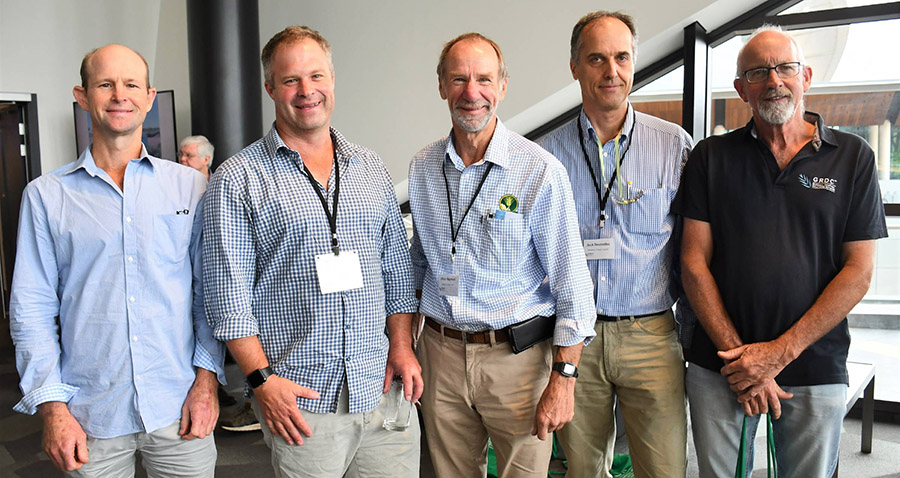South Australia's grains industry is preparing for the 2020 cropping season, armed with latest research findings, new knowledge and critical advice.
Information to support growers through this year and into the future was delivered at recent GRDC Grains Research Updates.
GRDC Grower Relations Manager - South, Courtney Ramsey, says - as the State's premier grains research, development and extension (RD&E) forum - the Adelaide Updates event has played an especially important role in equipping growers and advisers for the coming season.
"New findings and recommendations from GRDC investments in RD&E will inform SA growers' decision-making - not only over the coming production year, but well beyond," Ms Ramsey says.
"With its mix of forward-thinking advisers, growers and key industry representatives, the GRDC Grains Research Updates in Adelaide also provided a crucial opportunity for networking, sharing and debating ideas, access to researchers and an ability to provide direct feedback to inform future investment.
"At the two-day Updates, expert speakers from across the nation discussed future industry challenges and opportunities, along with more immediate, regional agronomic and tactical approaches - underpinned by outcomes from rigorous scientific research.

Larn McMurray, left, of Global Grain Genetics, Andrew Ware, of EPAG Research in Port Lincoln, Clare consultant Allan Mayfield, Jack Desbiolles, of the University of SA and Port Germein grower Barry Mudge. Photo: GRDC
Take aways
Ms Ramsey says some of the key messages delivered to growers and advisers attending the Adelaide Updates included:
- SA's grains industry is well poised to benefit from domestic market opportunities in eastern Australia;
- global trends will require the Australian grains industry to target unique opportunities to ensure it remains competitive in international markets;
- the southern grains industry will continue to deal with a climate that varies year-to-year and has a warming and, most likely, a drying trend;
- research has shown that highest yields for winter wheats come from April crop establishment;
- data from harvested 2019 winter crop variety trials, conducted through the GRDC's National Variety Trials (NVT) program, has now been finalised and fed into multi-year, multi-environment trial variety performance analysis for variety decision-making in 2020;
- sound, evidence-based science is reinforcing that snail baiting efficacy is higher earlier in the season than in spring;
- rotating pre-emergent herbicide modes of action and using other weed management practices will be essential to managing resistance in weeds to new herbicides;
- pulse-oilseed inter-cropping has the potential to increase productivity in the low rainfall environment;
- mapping frost damage for the purpose of cutting hay may be feasible, but these techniques require field validation;
- subsurface acidity and soil stratification are emerging as serious constraints to crop production across SA;
- an assessment of the regional performance of existing and new pasture legumes over two years has shown annual medics continue to provide the best pasture options for neutral/alkaline sandy soils in the Mallee region;
- potassium deficiency is likely on acid soils where hay cutting has occurred, whereas sulphur deficiency is likely on lighter, low organic matter soils after a wet summer;
- increasing the density of wheat and barley has been shown to improve the tolerance of these crops to competition from brome grass and ryegrass;
- a new disease risk alert system may ultimately remove the uncertainty around the timing of and need for fungicide sprays to control foliar disease in pulse crops;
- next generation sequencing technology and PREDICTA®B tests are revealing multiple potentially important soilborne pathogens of pulse and oilseed crops in Australia;
- low-cost, low-risk seed-based strategies have produced valuable benefits to wheat and barley establishment and grain yield in severely water-repellent sands;
- seeps are rapidly growing as a result of modern farming systems, and landscape and seasonal factors;
- the total cost of harvest weed seed control can be relatively small in the context of the overall farming system.

Allison Pearson, left, GRDC's Agronomy and Farming Systems Manager – South, with Nathan Robinson, of Federation University, Ballarat (Victoria) and Amie Sexton, of Federation University, Ballarat (Victoria). Photo: GRDC
More information about these and other topics presented at the Adelaide event is contained in papers delivered at this year's Grains Research Updates.
GRDC Research Code ORM1906-001SAX
More information: Courtney Ramsey, GRDC, 0428 274018, and papers delivered at this year's Grains Research Updates: https://grdc.com.au/resources-and-publications/grdc-update-papers























































